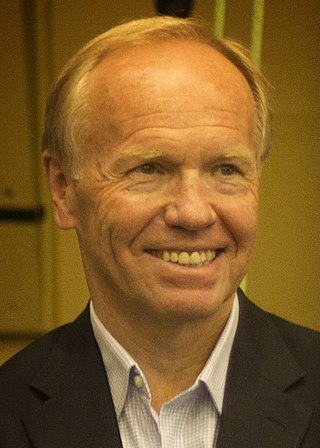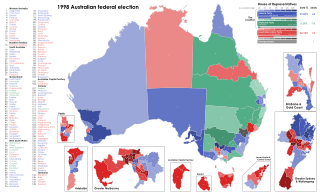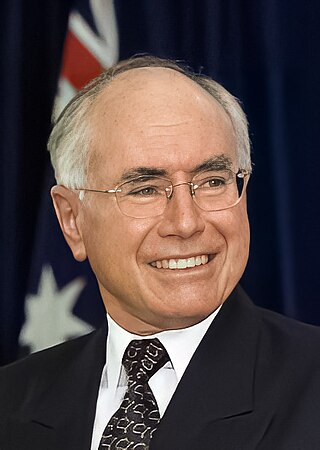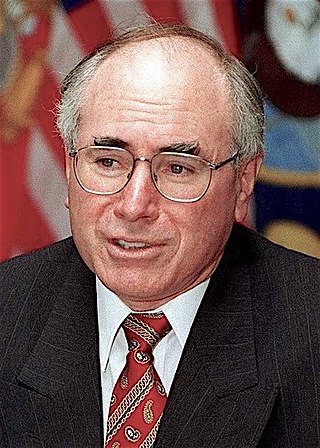
Peter Douglas Beattie is an Australian former politician who served as the 36th Premier of Queensland, in office from 1998 to 2007. He was the state leader of the Labor Party from 1996 to 2007.

The 1998 Australian federal election was held to determine the members of the 39th Parliament of Australia. It was held on 3 October 1998. All 148 seats of the House of Representatives and 40 seats of the 76-seat Senate were up for election. The incumbent centre-right Liberal/National Coalition government led by Prime Minister John Howard of the Liberal Party and coalition partner Tim Fischer of the National Party defeated the centre-left Australian Labor Party opposition led by Opposition Leader Kim Beazley, despite losing the nationwide popular and two-party preferred vote. However, the Australian Labor Party gained seats from the previous election.

The 2004 Australian federal election was held in Australia on 9 October 2004. All 150 seats in the House of Representatives and 40 seats in the 76-member Senate were up for election. The incumbent Liberal Party of Australia led by Prime Minister of Australia John Howard and coalition partner the National Party of Australia led by John Anderson defeated the opposition Australian Labor Party led by Mark Latham.

The 1996 Australian federal election was held to determine the members of the 38th Parliament of Australia. It was held on 2 March 1996. All 148 seats of the House of Representatives and 40 seats of the 76-seat Senate were up for election. The centre-right Liberal/National Coalition led by Opposition Leader John Howard of the Liberal Party and coalition partner Tim Fischer of the National Party defeated the incumbent centre-left Australian Labor Party government led by Prime Minister Paul Keating in a landslide victory. The Coalition won 94 seats in the House of Representatives, which is the largest number of seats held by a federal government to date, and only the second time a party had won over 90 seats at a federal election.
Robert Edward Borbidge is a former Australian politician who served as the 35th Premier of Queensland from 1996 to 1998. He was the leader of the Queensland branch of the National Party, and was the last member of that party to serve as premier. His term as premier was contemporaneous with the rise of the One Nation Party of Pauline Hanson, which would see him lose office within two years.

The Liberal–National Coalition, commonly known simply as the Coalition or the LNP, is an alliance of centre-right to right-wing political parties that forms one of the two major groupings in Australian federal politics. The two partners in the Coalition are the Liberal Party of Australia and the National Party of Australia. Its main opponent is the Australian Labor Party (ALP); the two forces are often regarded as operating in a two-party system. The Coalition was last in government from 2013 to 2022. The group is led by Peter Dutton, who succeeded Scott Morrison after the 2022 federal election.
Robert Joseph Quinn is an Australian Liberal Party politician in the Queensland parliament. He was leader of the Queensland Liberal Party from 2001 until being ousted on 7 August 2006 by Bruce Flegg.
Elizabeth Anne Cunningham is an Australian politician. She was an independent member of the Legislative Assembly of Queensland from 1995 to 2015, representing the electorate of Gladstone. A conservative MLA in a traditionally Labor district, Cunningham is perhaps most well known for having brought Rob Borbidge's Coalition minority government to power in 1996, following the loss of the Mundingburra by-election by the then Goss Labor government.

The Liberal National Party of Queensland (LNP) is a major political party in Queensland, Australia. It was formed in 2008 by a merger of the Queensland divisions of the Liberal Party and the National Party. At a federal level and in most other states, the two parties remain distinct and often operate as a Coalition. The LNP is a division of the Liberal Party of Australia, and an affiliate of the National Party of Australia.

The 2001 Queensland state election was held on 17 February 2001 to elect the 89 members of the state's Legislative Assembly. The result of the election was the return of the Labor Party (ALP) government of Premier Peter Beattie, with an increased majority in a landslide. Labor won 66 seats, easily the most it has ever won in Queensland and one of Labor's best-ever results nationwide. There was a 10.07% swing towards Labor, while One Nation suffered a 13.98% swing against it, losing eight seats.

Elections were held in the Australian state of Queensland on 15 July 1995 to elect the 89 members of the state's Legislative Assembly.

Elections were held in the Australian state of Queensland on 1 November 1986 to elect the 89 members of the state's Legislative Assembly. It followed a redistribution which increased the number of seats in the Assembly from 82 to 89.

Mundingburra is an electoral district of the Legislative Assembly in the Australian state of Queensland. It is currently held by Labor Party MP Les Walker.

The 1974 Australian federal election was held in Australia on 18 May 1974. All 127 seats in the House of Representatives and all 60 seats in the Senate were up for election, due to a double dissolution. The incumbent Labor Party led by Prime Minister Gough Whitlam defeated the opposition Liberal–Country coalition led by Billy Snedden. This marked the first time that a Labor leader won two consecutive elections.

The 1961 Australian federal election was held in Australia on 9 December 1961. All 122 seats in the House of Representatives and 31 of the 60 seats in the Senate were up for election. The incumbent Liberal–Country coalition led by Prime Minister Robert Menzies defeated the opposition Labor Party under Arthur Calwell, despite losing the two-party-preferred popular vote. In his first election as Labor leader, Calwell significantly reduced the Coalition's margin, gaining 15 seats to leave the government with only a two-seat majority. This was the first and only time that a Federal Government won a sixth consecutive term in office.
Peter William Wellington is an Australian politician. He was the independent member for Nicklin in the Queensland Legislative Assembly from 1998 to 2017, and served as Speaker from 2015 to 2017. Wellington has held the balance of power in the legislature twice in his career, and both times saw him give support to Labor-led minority governments.
The 1996 Mundingburra state by-election was a by-election held on 3 February 1996 for the Queensland Legislative Assembly seat of Mundingburra, located in the southern suburbs of Townsville. It was brought on by the Court of Disputed Returns declaring void the close result of the July 1995 election in the normally safe Labor seat, and resulted in the end of the Goss Ministry headed by Labor Premier Wayne Goss, and the swearing in of a minority government led by Nationals leader Rob Borbidge.
A by-election was held in the Legislative Assembly of Queensland seat of Mulgrave on 5 December 1998. It was triggered by the resignation of sitting One Nation member Charles Rappolt.
Francis John Tanti is a former Australian politician.

The 2020 Queensland state election was held on 31 October to elect all 93 members to the 57th Legislative Assembly of Queensland. The Labor Party was returned to government for a third-term, led by incumbent premier Annastacia Palaszczuk. With 47 seats needed to form a majority government, Labor won 52 seats, including all but five in Brisbane, while the Liberal National Party won 34 seats and formed opposition. On the crossbench, Katter's Australian Party retained its 3 seats, the Queensland Greens picked up South Brisbane for a total of 2, Pauline Hanson's One Nation retained Mirani and independent Sandy Bolton retained her seat of Noosa.


















